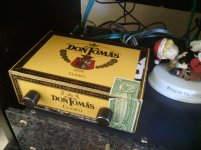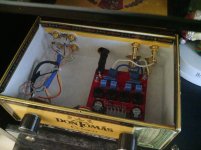Got my "YJ Blue board" today, played about 2 hours without change anything, very nice have to say.
Now I'm still thinking about how many power it can provide, on paper it says 2X50W, but that's 4 ohms, 24v, and maybe 10%THD, so if use 19.5V laptop PS as many people do, with a 8 ohms speaker, may only get 15-20W at 1% THD, that's a bit low.
One thing I've been thinking for a long time but didn't do is using 2 sure tpa3122 board with balance input, and PS can go up to 30V, then we can get 50W decent power at 8ohms
Now I'm still thinking about how many power it can provide, on paper it says 2X50W, but that's 4 ohms, 24v, and maybe 10%THD, so if use 19.5V laptop PS as many people do, with a 8 ohms speaker, may only get 15-20W at 1% THD, that's a bit low.
One thing I've been thinking for a long time but didn't do is using 2 sure tpa3122 board with balance input, and PS can go up to 30V, then we can get 50W decent power at 8ohms
Hi everyone!
I'm a newbie in electronics but I want to put together a valve preamp like here: 6N3 bile rectifier tube preamp streaking version ( with transformer )-in Home Appliances Stocks from Home Appliances on Aliexpress.com - already on the way and two TPA3116D2 boards as monoblocks for less THD. My speakers are open-baffle. Do you think it can make sense? Wich one of the so many boards can be the best?
Thank you!
I'm a newbie in electronics but I want to put together a valve preamp like here: 6N3 bile rectifier tube preamp streaking version ( with transformer )-in Home Appliances Stocks from Home Appliances on Aliexpress.com - already on the way and two TPA3116D2 boards as monoblocks for less THD. My speakers are open-baffle. Do you think it can make sense? Wich one of the so many boards can be the best?
Thank you!
Snakefast,
Welcome to this thread! The 3116 works very well with OB (http://www.diyaudio.com/forums/full-range/249984-cheap-fast-ob-literally.html)! I have used it and it offers excellent detail, transparency and soundstage. Bass extension is great too. Looking forward to hearing how a tube preamp sounds with the 3116. Regarding which boards are the "best" - it is tough to say as there are so many and I don't think we have too many reports on all of them yet. I have heard many people are quite happy with the basic YJ "Red" board, although with some mods the sound can be improved easily. The YJ "Blue" board (designed by Danzz) probably seems to be the current deluxe board for great sound quality and easy modification for upgrading caps, etc. I have also heard good things about the Ybdz board (which prompted me to buy it - and I really like it), and we have also heard nothing but praise for the green Audiobah board. They are so cheap, buy several and compare for yourself. I really want to try the Danzz blue board though - that is my next to buy. 🙂
Good luck and let us know what you decide on and how the tube preamp works!
Cheers,
X
Welcome to this thread! The 3116 works very well with OB (http://www.diyaudio.com/forums/full-range/249984-cheap-fast-ob-literally.html)! I have used it and it offers excellent detail, transparency and soundstage. Bass extension is great too. Looking forward to hearing how a tube preamp sounds with the 3116. Regarding which boards are the "best" - it is tough to say as there are so many and I don't think we have too many reports on all of them yet. I have heard many people are quite happy with the basic YJ "Red" board, although with some mods the sound can be improved easily. The YJ "Blue" board (designed by Danzz) probably seems to be the current deluxe board for great sound quality and easy modification for upgrading caps, etc. I have also heard good things about the Ybdz board (which prompted me to buy it - and I really like it), and we have also heard nothing but praise for the green Audiobah board. They are so cheap, buy several and compare for yourself. I really want to try the Danzz blue board though - that is my next to buy. 🙂
Good luck and let us know what you decide on and how the tube preamp works!
Cheers,
X
I have. It works great.
What pot did you use??
And you found gain to be ok??
Sideways,
I put mine together with a 25K pot from PE.
I measured the pot before installation. I wanted to make sure the channels would be equal, etc. They were within less than 1 percent tolerance.
With the pot "wide open" it was reading zero Ohms on my meter, so you should not worry about getting full signal to the board.
I'm going to start on my second amp this weekend, I'll be incorporating a rotary input switch, and a sub out using the same pot ( I bought 2 ).
This time I'll be building a little prettier chassis out of some Oak I have, not putting it in a WalMart plastic food storage container....
John
I put mine together with a 25K pot from PE.
I measured the pot before installation. I wanted to make sure the channels would be equal, etc. They were within less than 1 percent tolerance.
With the pot "wide open" it was reading zero Ohms on my meter, so you should not worry about getting full signal to the board.
I'm going to start on my second amp this weekend, I'll be incorporating a rotary input switch, and a sub out using the same pot ( I bought 2 ).
This time I'll be building a little prettier chassis out of some Oak I have, not putting it in a WalMart plastic food storage container....
John
What pot did you use??
And you found gain to be ok??
The gain of the TPA3116 is adjustable (20, 26, 32, 36)
26db works very well with my speakers.
I've used many different pots from 10-50K.
The pot shown in the photo is a Vishay conductive plastic 25K.
Snakefast,
Welcome to this thread! The 3116 works very well with OB (http://www.diyaudio.com/forums/full-range/249984-cheap-fast-ob-literally.html)! I have used it and it offers excellent detail, transparency and soundstage. Bass extension is great too. Looking forward to hearing how a tube preamp sounds with the 3116. Regarding which boards are the "best" - it is tough to say as there are so many and I don't think we have too many reports on all of them yet. I have heard many people are quite happy with the basic YJ "Red" board, although with some mods the sound can be improved easily. The YJ "Blue" board (designed by Danzz) probably seems to be the current deluxe board for great sound quality and easy modification for upgrading caps, etc. I have also heard good things about the Ybdz board (which prompted me to buy it - and I really like it), and we have also heard nothing but praise for the green Audiobah board. They are so cheap, buy several and compare for yourself. I really want to try the Danzz blue board though - that is my next to buy. 🙂
Good luck and let us know what you decide on and how the tube preamp works!
Cheers,
X
Thank you! So I've just ordered red, green and blue x2 🙂
sideways, I like your colorful package, and nice use of a source selector switch.
I am almost finished with a second Yuan Jing 2.0 blue amp build. In this case, I used a Panasonic EVJ 50kohm log taper pot. These seem to work well with these Texas Instruments Class D amps and they are very reasonably priced from Digikey in the US. I think I like these more than the Alps Blue Velvet.
I first removed the stock DC decoupling caps, the input caps and the inductors to begin the upgrade process. Removing the inductors was a bit tricky without ripping the surface mount pads from the amp board. I thought I could just heat the solder joints simultaneously with two solder irons and the inductors would fall off. However, the solder that Yuan Jing uses hardly reflows. I had to use a toothpick to apply some gel flux paste to the solder joints and heat the joints with my solder iron while very gently lifting the stock inductors off the board. I was able to neatly remove them all and keep the surface mount pads in place. After that, I had a lot of cleanup with alcohol and cotton swabs. You can see I couldn't get it spotless, but it was good enough.
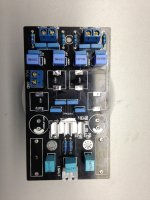
Next, I populated the board with the following:
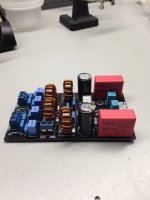
I wired up the amp with some Belden 88641 shielded twisted pair hook-up wire and tied the shields to the source end grounds only (i.e., RCA jack ground tabs). For mounting the board, I used Nylon standoffs and screws.
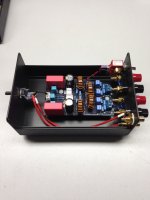
I still have to add a small green LED to indicate when the amp is powered on, but I've already started burning it in (please do not flame me if you do not believe in burning in audio circuits) using an Alan Parsons "Sound Check 2" test CD in repeat mode on my CD player.
I can only hear a very faint hiss with my ears next to my speakers, which are 98dB sensitive Klipsch Forte II floorstanding speakers. This unit is very quiet. To my ears, sound quality is typical when I install fresh Wima MKP10 coupling caps in a new circuit. I expect the sound to steadily improve, but it is very promising.
I will post a couple more photos later when I complete the amp.
I am almost finished with a second Yuan Jing 2.0 blue amp build. In this case, I used a Panasonic EVJ 50kohm log taper pot. These seem to work well with these Texas Instruments Class D amps and they are very reasonably priced from Digikey in the US. I think I like these more than the Alps Blue Velvet.
I first removed the stock DC decoupling caps, the input caps and the inductors to begin the upgrade process. Removing the inductors was a bit tricky without ripping the surface mount pads from the amp board. I thought I could just heat the solder joints simultaneously with two solder irons and the inductors would fall off. However, the solder that Yuan Jing uses hardly reflows. I had to use a toothpick to apply some gel flux paste to the solder joints and heat the joints with my solder iron while very gently lifting the stock inductors off the board. I was able to neatly remove them all and keep the surface mount pads in place. After that, I had a lot of cleanup with alcohol and cotton swabs. You can see I couldn't get it spotless, but it was good enough.

Next, I populated the board with the following:
- 1,500 uF / 25V Panasonic FM electrolytic caps for DC decoupling
- 1.0uF / 250V Wima MKP10 metallized Polypropylene caps for input coupling caps
- 10uH Bourns toroid inductors (recommended by KJA 2013 and wushuliu--thanks guys)

I wired up the amp with some Belden 88641 shielded twisted pair hook-up wire and tied the shields to the source end grounds only (i.e., RCA jack ground tabs). For mounting the board, I used Nylon standoffs and screws.

I still have to add a small green LED to indicate when the amp is powered on, but I've already started burning it in (please do not flame me if you do not believe in burning in audio circuits) using an Alan Parsons "Sound Check 2" test CD in repeat mode on my CD player.
I can only hear a very faint hiss with my ears next to my speakers, which are 98dB sensitive Klipsch Forte II floorstanding speakers. This unit is very quiet. To my ears, sound quality is typical when I install fresh Wima MKP10 coupling caps in a new circuit. I expect the sound to steadily improve, but it is very promising.
I will post a couple more photos later when I complete the amp.
That's awesome!! Thanks for the info!!
And yes...I do believe in burn-in...
Post when you find out how the upgrades you did over the stock board sound...I'm curious...
I know for me personally...sometimes "best" is not always "better"...seems to come with age LOL!!!
And yes...I do believe in burn-in...
Post when you find out how the upgrades you did over the stock board sound...I'm curious...
I know for me personally...sometimes "best" is not always "better"...seems to come with age LOL!!!
I'm not an electronics genius like Saturnus and the other guys around here, but I tried to do something creative for the TPA3116 community:
For those who want to build a custom enclosure, here are some .svg files that might be useful. I created them in Inkscape (free), these are laser cutout plans for 3mm plexiglass.
I tried to build a see-through enclosure of plexiglass and it looks great. It is built for the red YJ board but it can easily be adapted for the other boards.
The height is adjusted so Panasonic FC 35V 1500uF caps can be used, there is enough space for a CITEC volume pot and banana terminals, RCA jacks, a DC jack and a On/Off switch.
However, don't copy this 1:1, there are still some minor problems:
- Fragile hooks to click the casing together
- RCA jacks and banana terminals quite close together
I haven't installed the DC jack and on/off switch yet.
PS: I don't own the TI logo or the fonts used. The font is downloadable at Dafont.com and is called Aerolite.
The case is a heavily modified version of one of the Adafruit cases for raspberry pi.
PS2: The upgrade to Panasonic FC caps and CITEC potmeter has definitly upgraded the sound. It is now cleaner, with crisper highs and a better bass.
-----------------------------------------------
Now that's about as cool as it gets! Nice work!
Hey, tell us about where to source the CITEC volume pot you mentioned please.
Thanks,
Mark
Thanks. I'll install the LED later and hook it up to my tube line stage and phono stage in my main system. My initial impression is that the amp sounds more transparent. I can hear details I hadn't heard before with the stock blue amp, but it may be just in my head.
Thanks. I'll install the LED later and hook it up to my tube line stage and phono stage in my main system. My initial impression is that the amp sounds more transparent. I can hear details I hadn't heard before with the stock blue amp, but it may be just in my head.
Can you post the part numbers for all your part mods (Digikey?)
Rich,
Another trick is to just put a dab of solder (good solder, I use Kester 44) on each soldering iron tip then reach in there. You know, for when you don't have anything else. In fact I often add a little solder to chinese and other lead free or otherwise crappy solder, as it allows it to flow and suck up much nicer. A little more solder sucks better than a little less, too.
Another trick is to just put a dab of solder (good solder, I use Kester 44) on each soldering iron tip then reach in there. You know, for when you don't have anything else. In fact I often add a little solder to chinese and other lead free or otherwise crappy solder, as it allows it to flow and suck up much nicer. A little more solder sucks better than a little less, too.
Rich,
Another trick is to just put a dab of solder (good solder, I use Kester 44) on each soldering iron tip then reach in there. You know, for when you don't have anything else. In fact I often add a little solder to chinese and other lead free or otherwise crappy solder, as it allows it to flow and suck up much nicer. A little more solder sucks better than a little less, too.
Destroyer OS, that is a great tip. I've done that before with other Chinese-made electronics in the past for de-soldering caps and resistors. Since I wanted to be sure to get the original solder to flow easily, I used the gel flux paste. I think this saved the board from excessive heating.
Can you post the part numbers for all your part mods (Digikey?)
Here are the part nos. for the main components I replaced:
Panasonic FM electrolytic caps............Mouser 667-EEU-FM1E152
......................................................Digikey P12380-ND
Bourns 10uH inductors......................Mouser 652-2100HT-100-V-RC
......................................................Digikey 2100HT-100-V-RC-ND
Wima MKP10 film caps.......................Mouser 505-M101.0/250/5
Panasonic EVJ 50k pot.......................Digikey P2G1503-ND
I bought the Belden 88641 shielded hook-up wire from Jim McShane. I also get most of my tubes and other parts from Jim. Handmade Electronics might also carry the Belden shielded wire in small quantities.
Another cap I considered using was the Radio Shack 1uF / 250V metallized Polyester film cap. These look similar to Orange Drops, but are medium blue in color. Much is mentioned about these bargain film caps in an old T-amp coupling cap thread here on diyAudio.com.
I installed a small green LED, which sits behind a pin hole over the volume knob. It's bright enough to see in the day time, but not so bright at night.
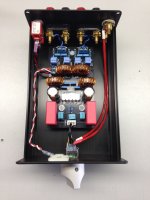

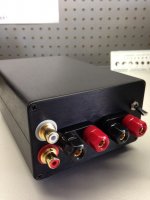
I have this amp hooked up to my ARC LS7 tube line stage, and it sounds very nice. This amp sounds cleaner than my near-stock YJ blue amp. The attack and decay of notes is more complete. Of course, I'll need to do more listening to make any final judgments.
rhing
noob alert: What is up with the toggle switch coming out of the PS area? I don't see where this is being fed power from. Also, did you solder that resistor inline on the LED and if so can you share with me what it is?
Thanks, lots of learning to do here.
noob alert: What is up with the toggle switch coming out of the PS area? I don't see where this is being fed power from. Also, did you solder that resistor inline on the LED and if so can you share with me what it is?
Thanks, lots of learning to do here.
- Home
- Amplifiers
- Class D
- TPA3116D2 Amp
